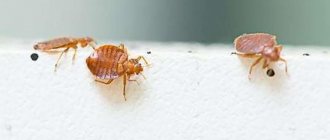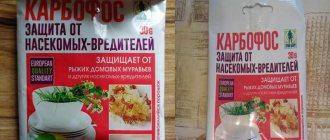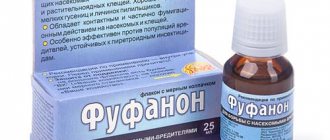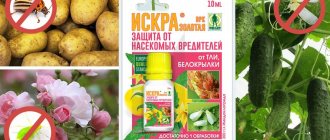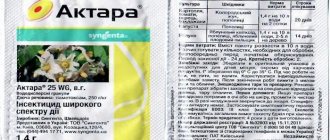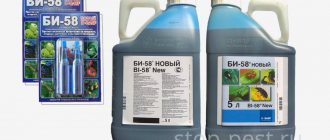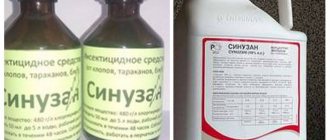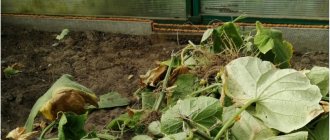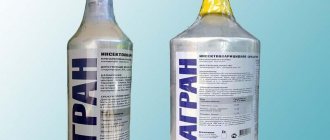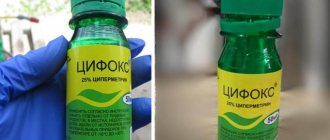Description of the drug, its characteristics and composition
“Fitoverm” is a IV generation drug with pronounced qualities of an insecticide (a means for exterminating insects) and an acaricide (an anti-mite treatment). In total, Fitoverm effectively fights more than 20 types of insect pests , which is why people resort to its use extremely often.
The most important positive quality of Fitoverm is its biological origin. The main active ingredient of this product is Avermectin, a toxin that affects the nervous system of insects. It is produced by the fungus Streptomyces Avermitilis. But this is if we are talking about the natural origin of the drug, because since 1984 synthesized analogues of the drug began to go on sale (however, they are no less effective).
There are 2 main ways that pests can enter the body:
- Contact exposure of avermectin to an insect (in this case, the greatest effectiveness was observed in the treatment of adult individuals).
- Intestinal effects - that is, toxins enter the digestive system of insects (with eaten green plant matter, fruits, water), but in this case the effect of the drug is noticeably weaker.
For reference . As already about, having a completely biological origin, it is preferable to many pesticides due to its relatively mild effect on crops. Even insects treated with the product do not die immediately, but only 1-3 days after treatment. By the way, ticks live for another 7-10 days after the poison enters their body, but throughout this period they lose the ability to reproduce and feed and move significantly less, causing less harm to humans and agricultural crops.
Non-toxicity towards plants is another big plus that can be added to Fitoverma’s collection. So, you can eat berries and fruits after 48 hours after treatment .
On a note . The product is easily destroyed by light, so it is recommended to carry out treatments before 7 am or after 7 pm. Otherwise, the requirements are standard: weather without precipitation and absence of strong wind is desirable.
Effective methods of control
The main thing is to figure out why springtails appeared at home, in open or closed ground. The main reason is excess soil and air moisture. To combat pests, you will have to eliminate the factors that attract insects.
How to proceed:
Folk remedies and recipes
It is not difficult to repel pests from orchids, violets, and camellias when using natural ingredients. Flower growers share their secrets of fighting tiny parasites.
Proven methods:
potato bait. The method is simple: divide the raw tuber into two halves, place the potatoes cut side down, and check the trap after 3-4 hours. Tiny insects actively gather around potatoes. The owners should quickly cover the piece of tuber with a bag or glass and remove the container along with the insects
It is important to act quickly, carefully, and remember: springtails on orchids, gloxinias, azaleas do not stay in one place for a long time, they jump to a new area,
wood ash against poisons. A good remedy for reducing the number of pests and reducing soil moisture
Directions for use: spread ash no more than 1 cm over the soil surface, reduce watering, reduce air humidity to optimal levels. For azaleas and camellias that prefer soils with high acidity, you should not use a natural component.
Preparations to combat springtails
Traditional methods are effective and safe for plants, but when the colony is large, potato baits and sprinkling the soil with wood ash do not give the desired result. Parasites actively gnaw at the roots, suck out the juices, and the plant weakens before our eyes.
In a difficult situation, it is important to treat the flower with proven drugs in a timely manner. Find out how to remove food moths from the kitchen using folk remedies and chemicals
Find out how to remove food moths from the kitchen using folk remedies and chemicals.
How to provide first aid and how to treat allergies to insect bites is written on this page.
Go to https://parazitam-stop.com/sad/rastenija/kapustnitsa.html and read about the reasons for the appearance and rules for controlling the cabbage butterfly in the garden.
Effective compositions for combating springtails:
Dimilin. Low-toxic product, active ingredient – diflubenzuron 250 g/kg. Broad-spectrum insecticide, insect growth regulator. Release form: wettable powder. A new generation drug with a residual effect of up to 40 days. The product is safe for people and animals (you should still not forget about measures to protect the skin, respiratory organs, and eyes), and quickly decomposes in water and soil. Regent. The product contains the active component fipronil, which disrupts the transmission of nerve impulses, causing paralysis in harmful insects. A contact-intestinal insecticide destroys a colony of pests in a few days. The drug is sold in two forms: ampoules with concentrated liquid and powder
When processing the soil, be careful; be sure to protect your eyes, respiratory organs, and skin from drops of the solution.
Bazudin. A long-acting drug protects plants from many soil pests
Active substance – diazinon, 100 g/kg. A hazard class 3 product with a pungent odor. Granules have a complex effect on parasites and pests. To kill insects in flowerpots with indoor flowers, dig granules to a depth of 1 cm. Podurs die within a day after using the drug, the residual effect lasts up to six weeks. A contact-intestinal insecticide with translaminar action does not harm plants.
In what cases is the use of Fitoverm prescribed?
The drug "Fitoverm" should be used when the first signs of plant infection by harmful insects appear.
Insect pests
The rule applies : indoor flowers can be treated as pests appear at any time, garden crops - during the growing season.
At the same time, the product can be used for all types of plants: gardening, ornamental, indoor.
As a rule, most of the varieties of the drug sold are a concentrated emulsion (coded “CE” on the packaging), which must be diluted with water before processing. There are also several variants of the drug:
- "Fitoverm-M" is a pesticide for treating plants in closed or open ground. Effective against all insects, it has equally insecticidal and acaricidal properties.
- "Fitoverm-P" is a highly specialized preparation intended for treating plants against nematodes.
- "Fitoverm" is an anti-tick agent.
- “Fitoverm-Forte” is a product with a particularly strong effect on insects (good as an emergency measure).
The most common containers for sale to consumers:
- Ampoules of 2.4 or 5 ml. Typically, this is an option for a small processing area. It is most often chosen for use on indoor plants. This is also the most common way to sell this drug.
- Bottles of different capacities (maximum up to 400 ml). This is a convenient way to use the product in a small private garden.
- Canisters up to 5 liters in volume are the most convenient option for large farms or agricultural complexes.
- Powder - only Fitoverm-P is produced in this form. It is also diluted with water.
Useful fact : plants, like the soil on the site, as well as the immunity of insects, get used to the Fitoverm preparation for a relatively long time. For example, it is permissible to use the product for up to 6 seasons in a row, giving nature a rest for the next 1-2 seasons, and then continue processing.
Control measures
There are several ways to control springtails. But in the early stages of infection, it is recommended to use folk recipes, and in advanced cases, chemicals.
Chemical
For the mass destruction of harmful insects, it is effective to use such means as:
Dimilin. The drug has a long duration of action - 40 days, is a low-toxic drug and has a wide range of effects. The active component of the insecticide is diflubenzuron, its quantity per 1 kg is 250 g. The popularity of the drug is due to its high effectiveness and safety not only for people, but also for pets. In addition, it stands out for its ability to quickly decompose in both soil and water. But in order to avoid negative consequences, you need to work with the insecticide in compliance with basic safety rules, protecting your eyes, skin, and respiratory organs. Regent. This contact-intestinal insecticide is capable of ridding the plant of springtails in 2-3 days. The drug is presented both in the form of ampoules and in powder form. The main component is fipronil, which causes paralysis in the parasite
It is also worth treating infected flowers with precautions. Bazudin
This product is effective against many types of pests of indoor plants, has a prolonged effect and belongs to the 3rd hazard class. The active component is diazonin, where per 1 kg of the drug there are 100 g of this substance. Its characteristic difference is its specific smell. Bazudin is used by deepening the granules 1 cm into the soil. The death of the parasites occurs within a day. The drug retains its effect for 6 weeks. Its undeniable advantage is the preservation of all plant development processes with regular use.
Traditional methods
Of the natural remedies used against the invasion of the dura, it is worth using:
- Potato bait. The recipe is quite simple: you need to cut a potato tuber in half and lay it with the cut on the surface of the soil. After 2-3 hours, you should check the trap for the presence of parasites; they should smell it and surround the bait. When this moment comes, the potatoes are removed from the pot, having previously been covered with a plastic bag. When carrying out such a manipulation, you should be extremely careful, given the increased activity of springtails.
- Wood ash. Podurs are very afraid of ash, even if you bury it just 1 cm into the soil, you can count on a positive result. In addition to reducing the number of parasites, this product can reduce the level of moisture in the soil. The only thing is that using wood ash to treat azaleas and camellias is not recommended, since these flowers prefer to grow in an environment with high acidity.
What pests does the product work against?
It is already well known that Fitoverm has a paralyzing effect on the nervous system of insects, inhibiting their needs for movement, nutrition and reproduction.
Among the most common pests that Fitoverm effectively copes with are:
- Colorado beetle;
- scale insect;
- butterfly;
- caterpillar;
- leaf roller;
- mole;
- thrips;
- codling moth;
- aphid;
- nematode;
- mealybug;
- mite.
Exceptions. There are options when Fitoverm is completely ineffective. For example, it is known that the product begins to act on an insect at least 2-24 hours after entering the body. This means that it is ineffective as an emergency measure. Locust infestations usually pass very quickly. Unfortunately, by the time the drug starts working, these insects will have already destroyed most of the crops.
Ambient air temperature has a great influence on the effectiveness of Fitoverm:
- At +15Co the drug loses half of its properties.
- At +25Co, insects are approximately 1.5 times more susceptible to poison.
- At +30Co, avermectins are absorbed by insects at least 8 times faster.
The decay of avermectins on soil usually does not exceed 24 hours. It can stay on the surface of plants for up to 72 hours, but no more. The product can be detected in water and soil up to 7 days after treatment.
By the way, “Fitoverm”, due to the rapid decomposition of the main active ingredient, is low toxic for beneficial insects - bees. On the other hand, it is important to follow the processing rules, namely, it is preferable to do this in the evening, so that the pests suffer overnight, and in the morning the drug is no longer so harmful to the bees.
"Fitoverm" from weevil
Weevil
Plants are usually treated for weevils quite early, because these insects begin to cause damage in early spring. However, it is important to carry out the treatment carefully, as the first bees or ground beetles can be poisoned.
Optimal concentration: 2 ml per 1 liter of water.
On the other hand, Fitoverm should be used only if the weevil population poses a serious threat to the seedlings.
How to breed from aphids
The peculiarity of Fitoverm treatment against aphids is that it affects only adult individuals, falling into their body through the digestive organs. Therefore, several treatments will be required, 3-4 in a row.
The concentration of the solution should be average: 4-8 ml of product per 1 liter of solution.
From whitefly
Whitefly
Control of whitefly will also require repeated treatment. Normally, the procedure will need to be repeated up to 4-5 times, with a break of 3 days between each treatment.
The solution should be diluted as follows: 2-4 ml per 1 liter of water. But for fruit crops it is better to reduce the concentration to 2 ml per 2-3 liters of water.
From the Colorado potato beetle
Treatment for the Colorado potato beetle should be carried out with a concentrated Fitoverma solution.
To prepare it, dilute 10 ml of the product in 10 liters of water and mix the mixture thoroughly. Then add another 9-10 liters of water and start spraying.
To improve the effect of the drug, you can add laundry soap to the solution in a proportion of 200 g. for every 10 liters of mixture (“Fitoverm” will stay on the surface of plants longer).
From onion fly
Onion fly
It is important to treat crops against onion fly very early - with the first onion shoots. The fact is that if the pest reaches the larval stage, it will develop in the integument of the plant, where the product will no longer harm it.
To combat onion flies, a solution of 4 ml “Fitoverma” per 1 liter of water is suitable.
This amount should be enough to process 1-2 m2 of area with onions.
Features of the drug Fitoverm
Fitoverm is a modern insectoacaricide, characterized by a contact-intestinal spectrum of action . It is thanks to this that the product can be used against various types of insects and mites. After treatment, the active substance quickly penetrates the skin of insects and into the gastrointestinal tract when eating leaves. The main active ingredient is Aversectin C, which causes paralysis in animals. After using this product, pests lose their ability to feed 7-8 hours after treatment. And within two days they die .
The Fitoverm insecticide decomposes inside the soil a month after treatment, and on the surface of plants after three days. This drug can be used even when plants are flowering. It is important to note that due to the rapid destruction of the main component, plants should be sprayed with phytoverm as needed. After the first treatment, only adults die, but larvae, nymphs and pupae will remain on the leaves. When they begin to feed on their own, you will need to spray again. This product is often purchased for treatment against whiteflies, mites, aphids and other pests .
Fitoverm is an effective drug of the fourth generation, which is distinguished by its biological effect. It was created on the basis of metabolic products of soil microorganisms, so it is practically safe, unlike other chemicals. During processing, people must follow basic safety rules - avoid contact with skin and mucous membranes. Before use, it is important to read the instructions and become familiar with the dosage of the drug.
Perhaps it is useful for all gardeners to know how to use potassium sulfate fertilizer.
Composition, release form
The product is produced. The insecticide is available in different forms, but most often it is a colorless liquid. The main component of the drug is Aversectin S.
Fitoverm can be packaged as follows:
- ampoules with a volume of 2 to 5 ml;
- bottles (up to 400 ml);
- canisters, maximum capacity – 5 l;
- isolated bags (concentrated emulsion);
- Fitoverm P powder, often used against nematodes.
To treat indoor plants with insecticide, 1 ampoule of minimum volume is enough. The amount of funds for open ground crops significantly exceeds the amount spent on home flowers.
It is more convenient to prepare a solution for the garden using canister packaging. The type of parasitic insects should also be taken into account. This will ensure the correct dosage when diluting Fitoverm.
Area of action of the drug Fitoverm
Fitoverm is a drug with a pronounced odor that is used for various purposes . It can be used not only to protect indoor plants, but also various crops. Fitoverm ke effectively copes with the following pests:
- Colorado beetle;
- white butterfly and cabbage butterfly;
- aphid;
- thrips;
- stalk;
- plant mite;
- moth;
- leaf roller;
- whitefly;
- mealybug;
- scale insect
Each person should remember that some insects and pests become accustomed to the components of the drug, so its effectiveness with prolonged use .
Indications for treatment
Fitoverm should be used if the following were noticed on indoor plants:
- Aphid. Yellow, green or black insects reaching 5 mm in length. Parts of plants on which aphids appear become sticky, often deformed, and flowers and shoots of the plant wither.
Aphid - Whitefly. Small insects that weaken flowers look like butterflies. They appear on the back of the leaves, and when the flower is shaken, they scatter.
Whitefly - Thrips. Rarely visible to the naked eye, but they leave many light spots on the outside of the leaves. Pests also attack buds and flowers.
Thrips - Ticks. The plant is partially covered with a thin cobweb, the leaves lose their rich color and die, and may become covered with white dots.
Common spider mite
Trips
A small black insect with an elongated body no more than 2 mm in length. Affects most smooth-leaved indoor plants. Clearly visible to the eye. Affected leaves have a rough surface and distinct eaten away spots.
Trips
Spider mite
It has a reddish or brown color, size no more than 0.5 mm. It is difficult to distinguish visually, but leaves obvious traces of its presence - a cobweb or whitish “dust” on the leaves. A plant affected by spider mites begins to wither, curl its leaves, lose tone, and turn yellow. Spider mites prefer roses, chrysanthemums, poinsettias, gardenias and other plants.
Spider mite
Aphid
A common pest that attacks roses, orchids, not only home plants, but also garden plants. It has a green body about 2 mm long, multiplies quickly, forming clearly visible colonies that cover the entire plant.
This is interesting: How to plant and grow Matthiola bicornuum from seeds
Aphid
In any case, even if you do not recognize among them the pest that is attacking your plants, but you see leaves that are damaged, eaten in places, stained, then you should use Fitoverm. Insects are not always noticeable, but they do their dirty work, so the plant must be saved.
Whitefly
To kill flying insects, the volume of liquid and chemical must be increased. Therefore, a whitefly solution must be prepared from 1.5 liters of water and 6 ml of insecticide. To remove the insect, two sprays are enough. The interval between procedures is a week. The effect of the drug is noticeable after three days.
Pros and cons of Fitoverm for indoor flowers
Fitoverm is loved by home gardeners due to its combination of low toxicity and high efficiency.
But these are not all the advantages of the drug:
- helps against a wide range of harmful insects;
- pests slowly get used to the poison;
- Fitoverm works well in a warm environment, which is easy to create at home;
- aversectin decomposes within 24 hours and does not penetrate the leaves and flowers of plants;
- the drug is relatively safe for animals and people;
- has an affordable price and long-lasting effect.
But this insectoacaricide also has its weaknesses:
- for the final destruction of pests, at least 3 treatments are needed;
- the solution easily rolls off the leaves, so adhesive substances are added to it - soap, shampoo;
- if there are a lot of insects, they may have time to cause irreparable damage to the plant before the remedy takes effect (therefore, in case of mass attacks, I advise immediately using Aktara);
- Fitoverm does not combine well with chemical pesticides and preparations with an alkaline reaction;
- the drug has an unpleasant odor of moderate intensity.
Hazard class and precautions
Fitoverm belongs to moderately hazardous substances (class 3). Before treating plants, it is necessary to avoid contact of the chemical with the skin and mucous membranes. The following personal protective equipment will help with this:
- latex gloves;
- mask;
- glasses.
It is advisable to dress in a suit or work clothes with long sleeves and trousers, and tie a headscarf or wear a hat. You must wear closed shoes on your feet. The safe working time with this chemical is 4 hours.
Treatment of orchids with phytoverm
Do not smoke, drink or eat food during treatment. Symptoms of poisoning include nausea and vomiting. If the drug accidentally enters the body, you must drink activated charcoal with plenty of liquid, rinse your stomach, and call an ambulance.
The remains of unused product can be disposed of in the sewer or plant soil. Do not pour the chemical into a sink in the house or into open water. After treatment, hands must be washed with soap.
Instructions for use "Fitoverma"
An extremely important feature of the use of Fitoverm is its concentration. It is individual for individual crops and certain pests. Beginners may have questions about this, but experienced gardeners usually immediately know what solution is needed.
Advice : all the necessary dosages (at least the main ones) are contained on the back of the drug packaging or in the instructions supplied with it.
Instructions for Fitoverm
How to dilute cabbage
The product is used against cutworms, white moths, cabbage moths and other pests. To work you need a solution:
- 4 ml of the drug per 1 liter of water.
The solution is sprayed onto each bush. Normally you need to spend about 4 liters per hundred square meters.
How to use for cucumbers
The product is necessary to combat thrips, mites and aphids. Solution:
- 8-10 ml per 1 liter of water.
Apply by spraying. Consumption: 10 liters per hundred square meters.
Use for strawberries
Methods of application against strawberries are rarely indicated in standard tables. However, Fitoverm also saves this crop from typical pests. To use you need a solution:
- No more than 2 ml per 1-1.3 liters of water.
All bushes and the soil underneath need to be treated. Pay special attention to the back of the leaves, where most of the pests hide. Approximate consumption of such a weak concentrate: 1 liter of solution per 1 m2.
How to breed for indoor plants
Indoor flowers are treated according to the principle: small concentrations are practically ineffective. Therefore, the solution must contain at least:
- 10 ml per 1 liter of water.
In this case, the plant must be treated for up to 3-4 days in a row until the pests are completely eliminated.
After each treatment, the premises must be ventilated!
For garlic and onions
For typical pests you need a more concentrated solution:
- 4 ml per 500 ml water.
Treatment method: spraying.
For roses
It may seem that for plants that do not produce fruits, potent compounds can be used. But that's not true. If you make a solution that is too concentrated, it will harm the decorative qualities of the bushes: it will deteriorate the quality of the flowers and increase the curvature of the stems.
Therefore, roses require small doses of the drug:
- For aphids, no more than 2 ml per 0.5 liter of water.
- For spider mites – 2 ml per 1 liter of water.
- For thrips - the highest concentration, 8 ml per 1 liter of water.
Roses should be treated by spraying.
Effective methods of control
The fight against insects takes place in several stages: identifying their location, general cleaning, and the use of various means that destroy adult individuals and their offspring.
Mechanical cleaning
The first thing to do is reduce the humidity in the house. In the warm season, it is enough to open the windows for fresh air. In damp or cold weather, you can use fans and air conditioners. It is necessary to inspect all possible corners, crevices, places under pipes, plumbing fixtures and dry them. Be sure to remove mold deposits, if any.
To avoid using mold cleaning agents that are aggressive to you and your pets, use traditional recipes:
- Dissolve two tablespoons of tea tree essential oil in 500 ml of water, apply to the surface using a spray bottle and leave for 12 hours;
- treat the desired surfaces with a mixture of water, vinegar, hydrogen peroxide and boric acid, proportions 4:2:2:1. Wipe the surfaces with a cloth soaked in liquid;
- You can treat the surfaces with a soap solution. Soap, if it gets on an insect, will “seal” its respiratory organs and, accordingly, it will die.
Potato bait
Regular potatoes will help lure the pest out of flower pots. You need to cut it into two parts and lay it on the surface of the soil with the cut side down. Springtails will not miss the opportunity to gather near a food source. Next, you need to act quickly: cover the insect trap with a bag and carefully remove it, throw away the potatoes.
Wood ash
Wood ash, in addition to fertilizing plants, absorbs excess moisture in the soil. Scatter it over the entire surface of the soil in a layer of 1 cm. In this case, no watering is carried out, and the air humidity is brought to a normal level.
Chemicals
Insecticides are used mainly on plants, but you can spray the places where you have seen springtails:
- “Aktara” - 0.1 g of the substance is dissolved in a liter of water, the product is applied both to the soil in the pot and to the leaves of the plant. The effect is long-lasting – up to six weeks;
- “Bazudin extra” - the contents of the ampoule (half) are dissolved in water at room temperature (4 l) and sprayed with a spray bottle. The effect of the drug appears after a few hours;
- “Regent” - an ampoule of the drug is diluted in a liter of water and sprayed on the places where pests have been identified, as well as the soil of flower plants.
You can also use insecticide concentrates for dilution and subsequent spraying from spray bottles, for example, “Lambda Zone”, “Delta Zone”, “Get”, or aerosols adapted for use against pests in apartments: “Clean House”, “Combat” , “Raptor”, “Armol” - they can also be used against springtails.
How quickly does the drug take effect?
Fitoverm is effective in pest control.
Typically, the drug begins to act on an insect 2 hours after entering its body. In some individuals, the effect may occur only after a day.
Most of the pests die on the third day (larvae and eggs faster). However, some ticks can maintain vital activity for up to 7 days after treatment of their habitats. True, they are no longer able to reproduce and eat noticeably less than usual.
What does a fool look like?
Collembula is a small insect whose body size ranges from 2 to 10 mm. Outwardly, it is very reminiscent of a caterpillar, painted white or beige. There are also springtails or poduras of yellow, gray and even metallic shades, with transverse stripes, a marbled or dotted pattern.
On the underside of the abdomen, the collembola has a fork-shaped process, thanks to which it not only moves along the soil, but is also able to jump. In a calm state, this jumping organ tucks under the abdomen and is practically invisible. This is the most obvious sign with which even a novice florist can recognize a subura. Below is a photo of a springtail.
Conventionally, springtails are divided into the following types:
- white podars are pests that live in the upper layers of the soil; they can especially often be found in greenhouses and hothouses where humidity levels are high;
- vegetable podurs are insects that eat ornamental plantings; they are also inhabitants of summer cottages;
- mushroom podurs - this type of pest can harm young shoots, seedlings and bulbous flowers.
Photos of different types of poduras can be seen below.
Fools
The number of springtails largely depends on the level of humidity: the higher it is, the faster the pests multiply. Over time, from the eggs laid by the female into the substrate, larvae appear, differing from adults only in size.
What analogues are there?
Fitoverm has a certain number of analogues. Foreign and domestic manufacturers produce more than 10 types of drugs, but they are all similar in that the active substance in all cases is avermectin or its synthesized analogues.
The following popular means can be noted:
- Spark BIO;
- Aktara;
- Agravertine;
- Aktellik;
- Aktofit;
- Kleschevitis;
- Abamectin (more toxic than Fitoverma);
- Vertimek (more toxic than Fitoverm).
Precautions for use
Personal protective equipment
The safety precautions observed by humans are similar to other work on treating plants against pests . “Fitoverm” belongs to hazard class III products, so you need to work with it:
- wearing tight clothing that covers most of the body and hair;
- wearing a respirator and thick gloves;
- wearing safety glasses.
Remains of the drug, as well as its packaging, must be disposed of carefully and responsibly. It is recommended to wrap the garbage in several layers of cellophane and tie the bag tightly.
During treatment it is forbidden to drink, eat and smoke. If the product gets on the mucous membrane, it should be rinsed with plenty of water. If nausea occurs, rinse the stomach and drink activated charcoal. If the condition does not improve, immediately seek professional medical help.
How to store the drug
The shelf life of Fitoverma is quite strict. All requirements specified in the instructions must be observed.
Open packaging usually does not retain its quality for long, therefore, if possible, you need to clearly calculate the amount of the drug and use most of it immediately after opening the ampoule/package/vial.
In general, the product must be stored out of the reach of children and animals. A very important condition: the temperature in the room should not be higher than +30С.
Advantages and disadvantages
According to reviews from flower growers who managed to test this insecticide in action, it has a number of positive qualities:
- effectiveness against ticks exceeds 96%;
- does not accumulate in plant tissues, quickly decomposes;
- non-phytotoxic;
- can be used during the flowering period;
- high temperatures do not reduce effectiveness;
- has a wide spectrum of action.
- It's inexpensive.
We suggest you read: How to deal with bedbugs at home: ways to identify parasites at home, methods of how to kill bedbugs
However, like other products, this insectoacaricide has disadvantages:
- leaves and flowers are not wetted too well when sprayed;
- processing alone is not enough;
- use together with chemicals is not allowed;
- washes off easily with water.
Answers to popular questions
In what proportion should Fitoverm be diluted?
For different crops and against different pests in different ways. Follow the instructions.
Can the product be used for prevention?
Yes, you can, but in smaller doses. By the way, it is much better to give preference to Fitoverm as a preventative measure than to dangerous pesticides.
How many times per season should Fitoverm be treated?
Usually until the pests are completely destroyed. In fact, this is about 4-5 applications per season.
How many days before harvest can Fitoverm be used?
It is advisable to wait several weeks without any treatment before harvesting. Although it is known that the product is completely removed from the soil in 5-7 days, and disintegrates on plants in 1-3 days. Fruits from the garden can be eaten within 48 hours after processing.
Conclusion
“Fitoverm” is rightfully considered one of the most convenient means of controlling most pests in the garden, in the garden, and on indoor plants. This product is a biological product, decomposes relatively quickly in light and is not capable of causing harm to humans (except for an allergic reaction).
Therefore, Fitoverm is successfully used not only in private farming, but also in entire agricultural complexes. It is effective, safer than strong pesticides, and easy to use. The success of this product lies in all this.
